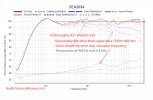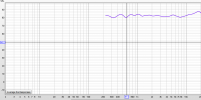This is a review and detailed measurements of the Audioengine A5+ powered bookshelf speaker. It is the one without the bluetooth which seems to have slightly different design (centered tweeter versus not). It was kindly loaned to me by a member and costs US $399 including Prime shipping from Amazon.
The A5+ is a hefty little speaker with very nice gloss finish:
View attachment 67174
A remote control is included for simple functions (volume, mute, etc.). The business end is in the back:
View attachment 67175
Unlike many budget powered monitors, the A5+ uses a linear power supply internally (as opposed to a laptop sized external power supply) which I appreciated it. It also eschews class D amps for traditional class AB amplification, hence the large heat sink in the back.
The crossover is passive by the way. This may be responsible for total lack of noise/hiss from the tweeter even when I put my ear next to it. A great benefit compared to a number of monitors which have annoying (but usually low level) hiss.
The slotted port is something I like as otherwise it can be annoying to have air pumped at your face when playing loud.
I should end this intro by saying that I have hardly had a good experience listening to these speakers at shows. They usually put them on a table chest high and play tracks on them which don't sound good to me.
Measurements that you are about to see were performed using the
Klippel Near-field Scanner (NFS). This is a robotic measurement system that analyzes the speaker all around and is able (using advanced mathematics and dual scan) to subtract room reflections (so where I measure it doesn't matter). It also measures the speaker at close distance ("near-field") which sharply reduces the impact of room noise.
Both of these factors enable testing in ordinary rooms yet results that can be more accurate than an anechoic chamber. In a nutshell, the measurements show the actual sound coming out of the speaker independent of the room.
Spinorama Audio Measurements
Acoustic measurements can be grouped in a way that can be perceptually analyzed to determine how good a speaker can be used. This so called spinorama shows us just about everything we need to know about the speaker with respect to tonality and some flaws:
View attachment 67176
Most important curve here is the on-axis (or listening window) which shows pretty flat (for speakers) response sans a wide valley around upper bass. Whether that is on purpose and part of the amplification EQ or design of the speaker, I don't know. But I take higher bass output when I can have it as I can always turn that down.
We see some peaks in on-axis which survive when measured all around the speaker as indicated in blue and red curves, indicating resonances.
I can't find the crossover spec but would guess around 2.5 to 3 kHz. Around that region we find that off and on-axis responses don't quite match as well as they do elsewhere. There is a waveguide but perhaps is not fully optimized.
Early reflections in a room that are loudest and hence most influential in tonality we hear is not bad:
View attachment 67177
Putting it all together, we get a pretty good response in a hypothetical average listening room:
View attachment 67178
The only issue is that recessed upper bass making for an interesting test case of how important that region is.
Distortion tests show that we have a problem around 800 to 900 Hz region:
View attachment 67179
Problem is there even at 86 dB (left side). We can see the issue in the context of overall response:
View attachment 67180
I accept distortion/noise in low frequencies but like to see none in the above calibrated graph above that region.
As an aside, as indicated on the graph, these are "in-room" measurements that are then corrected to remove the effect of the room. As such, the graph is free of room modes which corrupts distortion measurements.
The CSD/Waterfall is created thee same way and seems to show the same problematic frequencies:
View attachment 67181
Horizontal directivity plot shows reasonable response in that axis with rather smooth and broad response off-axis:
View attachment 67182
Here is a new way to look at the same but just with equal level contours:
View attachment 67183
The red line is the frequency at which we drop -6 dB. We see that we have better than +-55 degrees before that happens. That gives more freedom to move left and right without the tonality to shift. Given the near-field application of these speakers, this is good to see.
Response is reasonable until -12/+12 dB (pink line). But when we go past that to -18/+18 we see that the shape changes so we lose our off-axis similarity around crossover region but regain it at higher frequencies.
Finally, here is the vertical directivity:
View attachment 67540
Speaker Listening Tests
I tested the A5+ speaker on my test in the usual left position. It is on a 5 inch or so stand pointing up a few degrees. I have a "2-second" rule with speaker tests where I listen for the immediate reaction to the first track I play. It quickly sets in the impression for tonality. Here, the experience was good! No hand came out of the speaker and slap me to say, "I am too bright!"
That peak in bass was a good idea, providing clean impactful low bass hits. SPL (loudness) capability was also excellent. Yes, I could get it to distort but despite playing only one speaker, it could get surprisingly loud while maintaining that bass response. Gradually though, scratching sound would appear, telling you to back off.
I listened on and a lot of my reference tracks translated reasonably well but perfection was not there. The sound was a bit dull. So I went into Roon player EQ and started to add filters one by one. I wound up with three:
View attachment 67184
I added that broad increase centered around 300 Hz to make up for lack of energy there. I usually don't like increasing levels in EQ as that can push the speaker and lead to distortion. Not here. The subjective experience was definitely positive resulting in useful low frequency ambiance with almost no impact on how loud the A5+ could play.
Now the sound was a bit bright on some tracks. So I went after the high frequency resonance around 4.4 kHz. Knocked that down by 2 dB and that took care of most of that and cleaned up the highs a bit.
With that experience behind me, I figured I knock out the resonance around 900 Hz which happened to also coincide with peak distortion. Wow, that cleaned up the distortion very nicely without hardly any impact on tonality. You could so easily hear it in vocals and even higher frequency notes. Transient notes because much cleaner and less grungy for lack of a better word. I need to record this effect some day so you all know what I am hearing.
The combination of three filters transformed the A5+ from "OK and good" to "really good!" I sat there listening to track after track, enjoying each one of them. That nice bass was there now together with smooth, balanced response.
Conclusions
You can buy $100 powered monitors these days. So $400 seems quite a reach in the age of commoditization. Fortunately if you care about fidelity, the Audioengine A5+ delivers. It has higher than normal power and bass capability. And with a bit of equalization, produces truly high fidelity experience on your desktop.
As such, the
Audioengine A5+ gets my recommendation and changes my opinion of the company/brand.
-----------
As always, questions, comments, recommendations, etc. are welcome.
Since Sir
@Thomas savage did not show up for his weed pulling duty during spring here in our yard, I had to buy a truckload of compost to put in our garden to keep the weeds down. The bill? A cool $1000! Needless to say, I feel quite poor now and badly need cash infusion. So reach deep in your pocket and
donate what you can using
: https://www.audiosciencereview.com/forum/index.php?threads/how-to-support-audio-science-review.8150/


